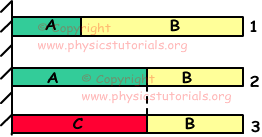Heat Temperature and Thermal Expansion Exam 2 and Problem Solutions
1. If Celsius thermometer shows the temperature of air 30⁰C, find the temperature of air in Fahrenheit thermometer.
 T(K)=T(C)+273
T(K)=T(C)+273
T=30+273=303⁰K
C/100=(F-32)/180
30/100=(F-32)/180
F=86⁰F
2. Find heat required to make 5g ice at -20⁰C to water at 30⁰C. (cice=0,5cal/g.⁰C, Lice=80cal/g, cwater=1cal/g.⁰C)
 Heat required to make ice at -20⁰C to ice at 0⁰C ;
Heat required to make ice at -20⁰C to ice at 0⁰C ;
Q₁=m.cice.ΔT=5.0,5.20
Q₁=50cal.
Heat required to make it melt;
Q₂=m.Lice=5.80
Q₂=400cal.
Heat to make it water at 30⁰C;
Q₃=m.cwater.ΔT=5.1.30
Q₃=150cal
Qtotal=Q₁+Q₂+Q₃=50+400+150=600cal
3. Two taps fill the water tank with different flow rates. Tap A fills the tank in 1 hour and tap B fills the tank in 3 hour If we open two taps together, find the final temperature of the water in the tank.
 Flow rates of taps;
Flow rates of taps;
VA=3VB
3m.c.(T-10)=m.c(50-T)
T=20⁰C
4. When we decrease the temperatures of the rods ΔT, relation between the final lengths of rods becomes; L₁<L₂<L₃. Find the relation between αA, αB and αC.
 Since change in length of the rod 1 is larger than the rod 2;
Since change in length of the rod 1 is larger than the rod 2;
αA<αB
Since change in length of the rod 2 is larger than the rod 3;
αC<αA
αC<αA<αB
5. Length vs. temperature graph of A, B and C is given below. Find the relation between λA, λB and λC.
 Slope of the graph=ΔL/ΔT=L₀.λ
Slope of the graph=ΔL/ΔT=L₀.λ
Initial length of A is larger than C but slopes of them are equal, so;
λC>λA
B and C have same length but slopes of them are different.
λB >λC
λB >λC>λA